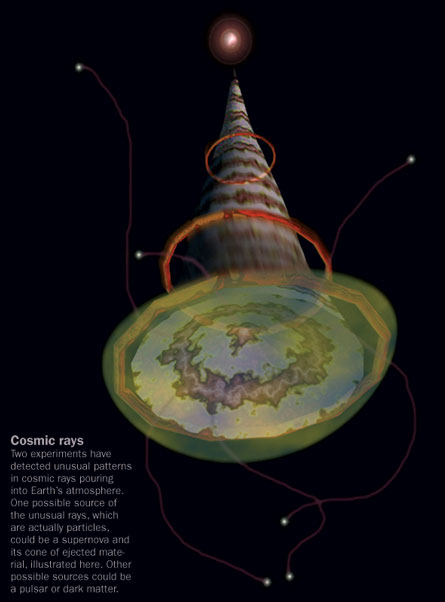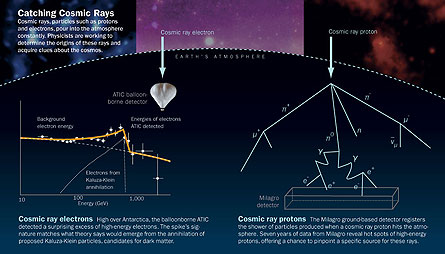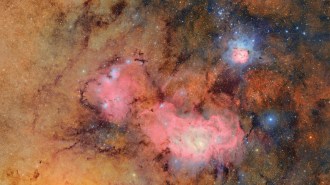There’s an air of excitement in the astrophysics community, created by a surplus of particles from space invading Earth’s atmosphere.


Balloon flights high in the stratosphere over Antarctica detected electrons in numbers and energies much higher than what usually pours in from space, scientists on a project called ATIC reported in November.
About the same time, a separate report from Milagro, a ground-based detector near Los Alamos, N.M., described two unexpected patches of high-energy protons in the sky. A review of seven years of Milagro data revealed an unusual distribution in the energies of these cosmic rays.
Both experiments seem to show that the Earth is being bombarded with high-energy cosmic rays from a mysterious, nearby source. But scientists aren’t sure whether the results are related.
“You can’t say yes, and you can’t say no, because they’re measuring something different,” says Jordan Goodman, a University of Maryland, College Park, physicist and spokesman for Milagro. The ATIC group “is seeing an excess of electrons, and we’re at higher energies seeing the protons.”
An as yet undetected source, perhaps a pulsar, might generate both protons and electrons at these energies, he says. “If this is the case, this would be very exciting because no one has yet definitively found a source of these high-energy cosmic ray protons.”
But if the events are unrelated, they suggest an even more tantalizing possibility: dark matter.
The findings have inspired efforts to use additional instruments to gather more clues. NASA’s recently launched Fermi Gamma-ray Space Telescope, for instance, could reveal any astrophysical objects that might be candidate culprits.
Not business as usual
Cosmic rays are actually subatomic particles, such as protons and electrons, that slam into the Earth’s atmosphere with a variety of energies. About 90 percent are protons. The rest are mostly helium nuclei, with a smattering of electrons.
Billions of cosmic ray particles hit Earth’s atmosphere every second; most come from the sun and are the low-energy variety. An energetic few, however, are believed to get an extra oomph because they are created by high-energy cosmic objects and events, such as supernovas or their occasional offspring, the spinning neutron stars known as pulsars.
Such high-energy cosmic rays have remained a mystery since the Austrian physicist Victor Hess discovered them in 1912. Nobody knows exactly where these rays come from or how they have been generated. But astrophysicists believe that a variety of astrophysical processes, such as shock waves from supernovas, can generate the high-energy rays.
Pinning down a specific source that generates high-energy cosmic rays has proven difficult. Because the magnetic fields of the galaxy and Earth scramble the flight paths of these particles, scientists have not been able to trace their trajectories back to their sources. This random scrambling effect means a map of cosmic ray intensities should appear completely uniform throughout the sky.
Or so scientists thought. In November, Milagro researchers reported seeing “hot spots” of high-energy cosmic ray protons in two distinct regions of the sky. It was the first time scientists could trace such protons back to a particular location.
Jordan and colleagues discovered the hot spots with the Milagro detector, which resembles a giant swimming pool. It is lined with light sensors that can record particles produced when cosmic ray protons collide with the atmosphere.
Researchers normally use the detector to investigate gamma rays, which also trigger a shower of particles. When the particles hit Milagro’s water tank they produce flashes of light that the sensors record. Actually, though, nearly all of the Milagro flashes are from cosmic ray protons, Goodman says. Identifying gamma rays requires routinely subtracting out cosmic ray background signals.
In 200 billion cosmic ray collisions recorded during a seven-year period ending in April 2008, the scientists found two areas of the sky that appeared to have an excess number of high-energy protons in the background. The protons also appeared to have a higher average energy — up to 10,000 trillion electronvolts — than the background.
It’s hard to imagine any peculiarity of the detector that would give particular regions of the sky higher energies, Goodman says. “The fact that it’s a relatively small scale and it’s definitely an excess is a tip that it’s a real phenomenon.”
The excess in the localized regions, he says, could show a “propagation effect,” created when high-energy rays are funneled from a distant source.
But more likely, he says, the protons are produced near black holes or neutron stars, astrophysical objects capable of accelerating particles to high energies. The protons may also get their energy from a nearby pulsar, such as Geminga, a relatively young pulsar surrounded by a highly magnetized nebula capable of generating high-energy particles.
Geminga, or some other nearby source, may also be the culprit generating high-energy electrons, such as those recently captured over Antarctica. The balloonborne ATIC, or Advanced Thin Ionization Calorimeter, counted 70 excess electrons above the usual number expected from the galactic background. While that may not sound like a lot of electrons, statistically speaking it’s a significant surplus, says Yousaf Butt, an astrophysicist at the Harvard-Smithsonian Center for Astrophysics. The findings and Butt’s commentary appeared last November in Nature.
High energies are for WIMPs
Butt says there are at least two possible explanations for the electron spike. One, the electrons could come from a nearby astrophysical object, such as a pulsar or microquasar, that propelled the electrons to high energies.
An alternative explanation is that the electrons were produced by dark matter. Dark matter is believed to account for 85 percent of the universe’s mass, though scientists have yet to identify what it is made of. A few exotic particles have been suggested as prime candidates for dark matter, including WIMPs — weakly interacting massive particles. Two WIMPs meeting and annihilating each other could produce a spray of particle and antiparticle pairs, such as positrons and electrons. Such a collision would produce a peak in the spectrum of electron energies.
The ATIC balloon collaboration, led by John Wefel of Louisiana State University in Baton Rouge, found such a bump in the spectrum of cosmic ray electrons during five weeks of ballooning in 2000 and 2003. What’s more, the signal peaked at 620 gigaelectronvolts and then rapidly declined to the background level. Butt says the signature is a kind that would emerge if a WIMP known as a Kaluza-Klein particle was a prime dark matter component.
If they are real, Kaluza-Klein particles would owe their existence to “extra” dimensions beyond the three of ordinary experience. Theoretically, these particles travel in the extra dimensions, but should they collide and annihilate they would spit out electrons and positrons that would travel through the ordinary dimensions and could therefore be detected.
While bumps in the cosmic ray electron spectrum have been measured before, they didn’t cover the energy range seen in the ATIC experiment, Butt says. Last fall, for example, scientists reported hints of dark matter in measurements taken by the Russian-European orbiting observatory known as PAMELA (SN: 9/27/08, p. 8). The findings were based on measurements of positrons, the electron’s antiparticle. While they don’t encompass the energy range ATIC detected, the PAMELA measurements are consistent with the ATIC results, says Butt. Together, the two data sets bolster the case for Kaluza-Klein dark matter.
Dan Hooper, a theoretical physicist at the University of Chicago, says the presence of another theoretical dark matter particle — the neutralino — could account for the bump in the cosmic ray electron spectrum. He presented his idea in a recent paper posted online (arxiv.org/abs/0812.3202).
Neutralinos would also be WIMPs and are favored by models invoking a special type of dark matter: cold dark matter, which moves relatively slowly. Typically, annihilation of neutralino dark matter would not produce the bump in the cosmic ray spectrum seen in the PAMELA and ATIC experiments, Hooper says.
“However, if we abandon the assumption that neutralinos are distributed throughout the galaxy in a smooth way, but instead imagine that there happens to be a big clump of the dark matter nearby, then you can get something that climbs with energy like these experiments see,” he says.
Some scientists express caution in reading too much from the recent studies. Greg Tarlé, an astrophysicist at the University of Michigan in Ann Arbor, says despite these groups’ careful analyses, getting rid of the background is difficult. In the 1990s, Tarlé helped launch a balloonborne experiment called HEAT that flew over New Mexico. The experiment was the first to measure the positron spectrum in cosmic rays, as reported in Physical Review Letters in 2001.
“One of the most important things in these measurements is to get rid of protons that may masquerade as positrons,” he says. “In the HEAT experiment we did that by measuring and separating protons and positrons in three different ways.”
When the group eliminated any one of those techniques, the number of positrons rose. “That’s why, when I look at the new results, PAMELA results for example, and I see a rising positron fraction, it looks just like the rising fraction that we saw when we turned off our TRD,” one of the correction methods, Tarlé says.
More dots to connect
Determining whether the bump was caused by a nearby source, such as a pulsar, or by the annihilation of dark matter will require more data from a variety of instruments, the scientists say.
“I think the clearest way to settle this is to try to measure the sharpness of the peak of this electron bump,” Butt says. “If it’s an astrophysical object, like a pulsar or a microquasar, that’s making this electron bump, it’s going to be a smooth bump.” But if it’s really from the decay of dark matter particles, the energy spectrum bump will have a characteristic sharp peak and sudden drop, he says.
To get such measurements, scientists need a variety of instruments to collect electron events over a wide energy range for a long period of time. A Japanese group, led by Shoji Torii of Waseda University, is designing an instrument called CALorimetric Electron Telescope, or CALET, with the hope that it will be placed on the International Space Station in 2013. CALET would collect electrons over Earth for at least 1,000 days, Torii says, as opposed to ATIC’s five weeks.
Earlier results, Butt says, could come if the Large Hadron Collider near Geneva provides insights into annihilation of dark matter particles. By tuning the collider’s beams to 620 GeV — the proposed energy range of Kaluza-Klein particles — scientists could simulate or re-create what they observed in the sky. While such studies wouldn’t detect dark matter particles, they could be used to scan this peak energy region for a corresponding excess of electrons in the LHC, Butt says.
Hooper suggests that ground-based gamma ray telescopes, such as the High Energy Stereoscopic System (H.E.S.S.) in southern Africa, or the Very Energetic Radiation Imaging Telescope Array System (VERITAS) located on Mount Hopkins in Arizona, could be used to collect huge numbers of electrons. Even though these telescopes are designed to study gamma rays, they can also detect electrons. Hooper and coauthor Jeter Hall of Fermilab in Batavia, Ill., propose a strategy for doing so in a recent paper posted online (arxiv.org/abs/0811.3362).
“The advantage is that they can see hundreds of thousands of square meters of electrons at a given time,” Hooper says. “So they can collect hundreds of thousands times more electrons in this way than the balloon experiment.”
Using all of these resources, scientists may soon be able to get to the bottom of the cosmic ray mystery, Butt says. “Between all the various efforts, I think within the next two years, we should be able to say either yes or no as to whether or not these features seen in the electron spectrum are due to dark matter or something else.”
Susan Gaidos is a freelance science writer in Maine.







